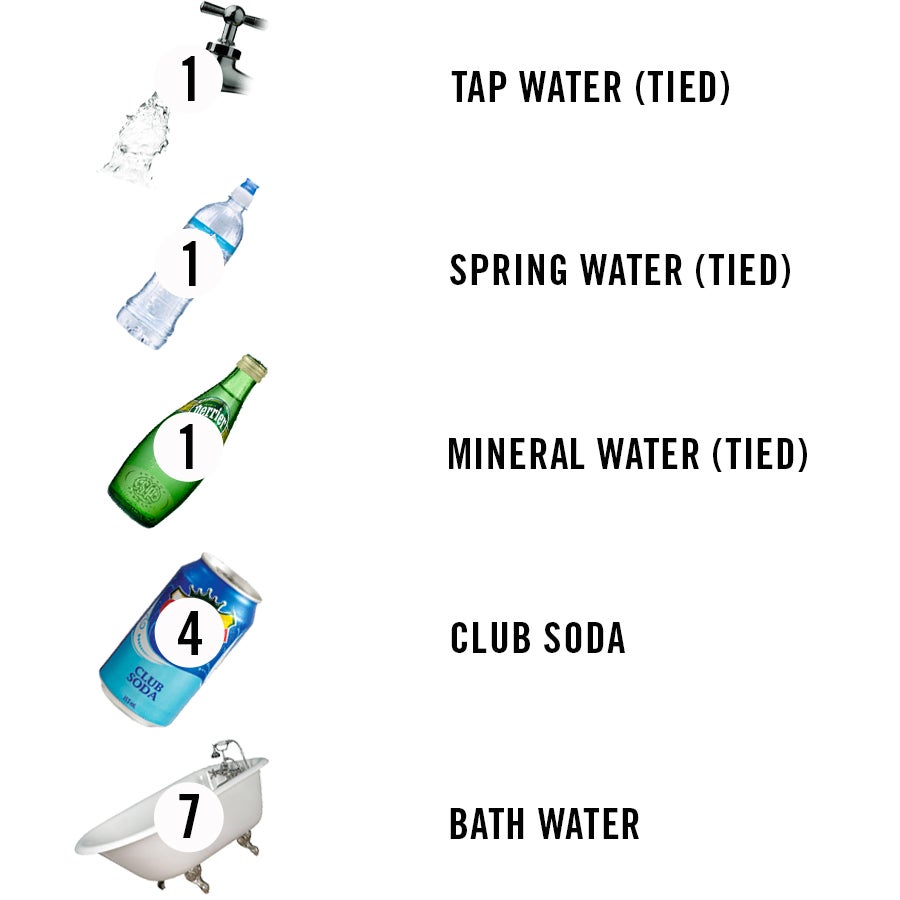Water is like, really great, man — it quite literally keeps pretty much everything on the planet alive. And while there are several options to choose from when it comes to staying hydrated, some are significantly better than others.
To encourage responsible sipping, I asked Dana Hunnes, senior dietitian at the Ronald Reagan UCLA Medical Center, to help me rank several kinds of water by how healthy they are — from life-giving to seriously dangerous.
But first, a quick note on the environmental impact of plastic water bottles. “Glass and aluminum are the most environmentally friendly, as both can be nearly infinitely recycled, whereas 91 percent of all plastic products are never recycled and end up in landfills or the ocean, where they almost never biodegrade (but can photodegrade), possibly leading to microplastics that end up in seafood,” Hunnes explains. “Plus, plastic leaches chemical compounds, which can mimic our own hormones and may be obesity-promoting and bad for our reproductive health. I would always go for glass or metal bottles first — even better, buy your own to reuse.”
One other thing worth mentioning before diving into our ranking: In addition to ranking kinds of water by their health impact, Hunnes also took the time to rank them by how much they cost, which she says “is ridiculous for bottled water.” So unlike our other rankings, which typically consist of only one list, this ranking will have two, the first being based on health and the second on cost.
Now that we’re all clear, here’s our health ranking.

1) Tap, Spring and Mineral Water (tied): “Tap, spring and mineral water all are pretty much at the top, since they’re all essentially just H2O with either minerals added or naturally occurring minerals,” Hunnes explains. Some of those minerals include calcium and magnesium, and thanks to them, studies show that mineral water contributes to stronger bones and healthy digestion more so than non-mineral water. Mineral water can flow straight from your tap, though. “In many cases, ‘spring’ or ‘mineral’ water are sourced from the same place as municipal tap water,” Hunnes says. “It’s just that companies like to price-gouge and charge hundreds of times the cost of water by putting it in a bottle.” Since we’re talking tap water, I should also quickly mention that Brita filters do basically nothing.
4) Club Soda and Seltzer (tied): “Both of these are essentially carbonated water,” Hunnes says. “Seltzer tends to have more minerals, either added or naturally occurring, and more sodium. These aren’t as healthy as flat water because the carbonation makes it acidic and could potentially increase tooth enamel demineralization (loss of tooth enamel).”
6) Tonic Water: “Historically, tonic water was made with higher doses of quinine, a malarial-prophylactic medication to protect against malaria,” says Hunnes, adding that quinine is quite bitter, meaning tonic water is often sweetened. “Today’s commercial tonic waters contain small amounts of quinine and quite a bit of sugar syrup, so this is basically a bitter, sugary sparkling beverage — not so good for you. It’s basically like drinking soda.” In fact, one 12-ounce serving of Schweppes tonic water boasts a whopping 32 grams of sugar, which is only a little less than a can of Sprite.
7) Raw Water and Bath Water (tied): “Raw water is untreated water gathered from either the ground or perhaps a well,” Hunnes explains. “This isn’t generally safe for human consumption, unless it’s been boiled or treated in some way to rid it of possible parasites, bacteria or other contaminants. I would avoid this.”
The same could be said — and I’m pretty upset that I even need to say this (thanks a bunch, Belle Delphine) — about drinking your own sweat-and-soap-ridden bath water, a strange phenomenon with a devoted group of active participants on (surprise) Reddit.
Now let’s move on to the cost ranking, which is actually pretty similar to the health one.
1) Tap Water: “This is by far the least expensive option, as you get it out of a tap,” Hunnes says. “While not ‘free,’ it essentially is. It usually only costs .01 or fewer cents per gallon.”
2) Spring and Mineral Water (tied): “Spring and mineral waters can vary in price: One of the cheapest I saw was $2.50 for 12 half-liter bottles, or about $1.67 per gallon,” says Hunnes. “This is still much more than tap water when it’s essentially the same thing. Plus, you can also buy mineral waters that are much more expensive (Icelandic Glacial, for example) for about $12 a gallon.”
4) Seltzer and Club Soda (tied): “These tend to be the next most expensive, as you can usually by them at $1 for each two-liter bottle,” Hunnes explains. “However, the plastic in the bottles is environmentally deleterious, and when you think about it, you’re basically paying $2 per gallon for these, versus the minimal amount you’d be paying for tap water. You do get bubbles with these, however.”
There’s a cheaper route to bubbly water, though. “You could buy a SodaStream for $90 (or $72 with a 20 percent off coupon) at Bed Bath & Beyond, then get gas refills for $15 (or $12 using a coupon) each,” Hunnes suggests. “You’ll get about 60 liters of carbonated water, so over the course of a year, that will cost about $1.20 per gallon. The second year will be even cheaper, because you don’t need to repurchase the SodaStream.”
6) Tonic Water: “The cheapest tonic water I saw was around $25 for about 6 liters,” Hunnes says. “This rounds out to be about $16 per gallon. That’s ridiculous if you ask me!”
7) Raw Water: “It’s probably free to extract, but the health toll it will take is far too expensive,” Hunnes warns.
So to sum up everything we learned today, drinking straight from your kitchen sink is basically the best option, always. And for Christ’s sake, enough with drinking your filthy bathwater.

